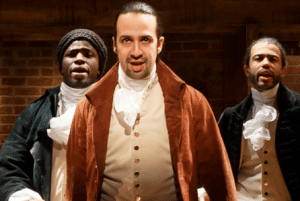
 Even before Lin-Manuel Miranda’s new musical, Hamilton, opened at off-Broadway’s Public Theater months ago, the buzz was so hot that speculation had the production searching frantically for a Broadway theater to overtake before the end of last season. Rapturous reviews greeted the hip-hop-style tuner, about America’s first Secretary of the Treasury, but the producers still chose to wait until this season to bring Hamilton to Broadway.
Even before Lin-Manuel Miranda’s new musical, Hamilton, opened at off-Broadway’s Public Theater months ago, the buzz was so hot that speculation had the production searching frantically for a Broadway theater to overtake before the end of last season. Rapturous reviews greeted the hip-hop-style tuner, about America’s first Secretary of the Treasury, but the producers still chose to wait until this season to bring Hamilton to Broadway.
Any fears of momentum flagging were quickly dispelled when the show began previews July 13 at the Richard Rodgers Theater. Seating was SRO, with box-office takes (in the 1.3 million range) zooming to 10 percent over the theater’s weekly potential for grosses. And, as a boost for publicity, no less than President Obama took in the show the second week of previews.
In other words, Hamilton is a juggernaut—no matter how the critics weighed in tonight, Aug. 6, the show’s official Broadway opening. Nevertheless, good pull quotes can’t hurt down the line and at awards time, and there’s always the fear that a show that played like gangbusters downtown might be less effective on a Main Stem stage.
 But the opposite was true for AM New York’s Matt Windman, who admits he had his reservations when he first saw Hamilton off Broadway. Back then, he found the plot “too dense” and the “hip-hop sound monotonous.” However, this time, “On second viewing, I ended up being absolutely entranced by Miranda's inventive writing, Thomas Kail's masterful direction and Andy Blankenbuehler's nonstop movement. I may be the last critic to join the Hamilton fan club, but better late than never.” He closes the review noting that the musical will likely bring all different types of audiences to the Richard Rodgers Theater, and “isn’t that what great musicals are supposed to do?”
But the opposite was true for AM New York’s Matt Windman, who admits he had his reservations when he first saw Hamilton off Broadway. Back then, he found the plot “too dense” and the “hip-hop sound monotonous.” However, this time, “On second viewing, I ended up being absolutely entranced by Miranda's inventive writing, Thomas Kail's masterful direction and Andy Blankenbuehler's nonstop movement. I may be the last critic to join the Hamilton fan club, but better late than never.” He closes the review noting that the musical will likely bring all different types of audiences to the Richard Rodgers Theater, and “isn’t that what great musicals are supposed to do?”
 Variety’s Marilyn Stasio, who loved the show downtown, hasn’t changed her tune. “Like any true landmark,” she writes, “Hamilton stands up to repeated viewings. After six months, the show’s initial impact hasn’t dulled a bit; in fact, the qualities that made it so extraordinary the first time around are all the more striking.” She also notes that Miranda’s “amazing” score adds a “thrilling contribution” to the American musical theater.
Variety’s Marilyn Stasio, who loved the show downtown, hasn’t changed her tune. “Like any true landmark,” she writes, “Hamilton stands up to repeated viewings. After six months, the show’s initial impact hasn’t dulled a bit; in fact, the qualities that made it so extraordinary the first time around are all the more striking.” She also notes that Miranda’s “amazing” score adds a “thrilling contribution” to the American musical theater.
 No less ecstatic is Chris Jones of The Chicago Tribune, who raves that this “audaciously ambitious and supremely executed new musical is surely the most entertaining, provocative and moving civics lesson in Broadway history.” He adds that the show is “extraordinary” for its reminder that the U.S. was founded by “energetic and intensely radical” young men. Jones also lauds the “sensational ensemble” and director Thomas Kail’s ability to forge “a wholly consistent world.”
No less ecstatic is Chris Jones of The Chicago Tribune, who raves that this “audaciously ambitious and supremely executed new musical is surely the most entertaining, provocative and moving civics lesson in Broadway history.” He adds that the show is “extraordinary” for its reminder that the U.S. was founded by “energetic and intensely radical” young men. Jones also lauds the “sensational ensemble” and director Thomas Kail’s ability to forge “a wholly consistent world.”
 Ben Brantley, chief critic of The New York Times, says it all in the first sentence: “Yes, it really is that good.” For him, the show is “proof that the American musical is not only surviving but also evolving in ways that should allow it to thrive and transmogrify in years to come.”
Ben Brantley, chief critic of The New York Times, says it all in the first sentence: “Yes, it really is that good.” For him, the show is “proof that the American musical is not only surviving but also evolving in ways that should allow it to thrive and transmogrify in years to come.”
 Associated Press critic Mark Kennedy finds some minor flaws in the second act, but the show’s “sheer brashness and freshness” carry the day. He singles out Leslie Odom Jr.’s Aaron Burr and the “glorious” Renee Elise Goldsberry for special praise.
Associated Press critic Mark Kennedy finds some minor flaws in the second act, but the show’s “sheer brashness and freshness” carry the day. He singles out Leslie Odom Jr.’s Aaron Burr and the “glorious” Renee Elise Goldsberry for special praise.
 Frank Scheck of The Hollywood Reporter praises Hamilton for “packing immense amounts of detail into its sprawling narrative. But it does so in such riotously entertaining fashion that it never feels like a history lesson, although it surely delivers one.” Scheck closes his review by saying this musical “triumph” posits the “immensely talented” Miranda as “a game-changing figure in musical theater.”
Frank Scheck of The Hollywood Reporter praises Hamilton for “packing immense amounts of detail into its sprawling narrative. But it does so in such riotously entertaining fashion that it never feels like a history lesson, although it surely delivers one.” Scheck closes his review by saying this musical “triumph” posits the “immensely talented” Miranda as “a game-changing figure in musical theater.”
 “Hamilton is the best and most important Broadway musical of the past decade,” writes Wall Street Journal critic Terry Teachout. As he did off-Broadway, Teachout wishes the show were slightly shorter than 2 hrs and 45 minutes, but “the vaulting energy of Mr. Miranda’s score sweeps all cavils aside,” while Kail, choreographer Andy Blankenbuehler and designer David Korins have “successfully expanded the scale of the original production without making it top-heavy.”
“Hamilton is the best and most important Broadway musical of the past decade,” writes Wall Street Journal critic Terry Teachout. As he did off-Broadway, Teachout wishes the show were slightly shorter than 2 hrs and 45 minutes, but “the vaulting energy of Mr. Miranda’s score sweeps all cavils aside,” while Kail, choreographer Andy Blankenbuehler and designer David Korins have “successfully expanded the scale of the original production without making it top-heavy.”
 In full agreement is Newsday’s Linda Winer, who says the show is “even more nuanced, more cohesive in individual performances and more focused [in its] finale” than it was at the Public Theater. “Most important,” she notes, is that “Miranda and director Thomas Kail have fine-tuned it without losing a shiver of its audacity and thrill.”
In full agreement is Newsday’s Linda Winer, who says the show is “even more nuanced, more cohesive in individual performances and more focused [in its] finale” than it was at the Public Theater. “Most important,” she notes, is that “Miranda and director Thomas Kail have fine-tuned it without losing a shiver of its audacity and thrill.”
 Giving the musical **** (out of 4), USA Today’s Elysa Gardner raves, “there has been nothing on Broadway in the past 20 years to rival the riveting, exhilarating and haunting Hamilton.” She particularly lauds “Miranda's pulsing score and dazzling, piercing rhymes.”
Giving the musical **** (out of 4), USA Today’s Elysa Gardner raves, “there has been nothing on Broadway in the past 20 years to rival the riveting, exhilarating and haunting Hamilton.” She particularly lauds “Miranda's pulsing score and dazzling, piercing rhymes.”
 Joe Dziemianowicz begins his ***** (out of 5) review for the Daily News by kvelling, “With Hamilton, Broadway is officially the coolest place on the planet. And the smartest. And most exhilarating. [The show is] even richer and more eloquent since its run earlier this year at the Public Theater.” Dziemianowicz also notes, “Since the Off-Broadway run, performances have all deepened, including Miranda’s. He better conveys Hamilton’s cockiness, contrition and all-too-human flaws.” “A slightly sluggish second act” aside, Hamilton is “a one-of-a-kind theatrical experience.”
Joe Dziemianowicz begins his ***** (out of 5) review for the Daily News by kvelling, “With Hamilton, Broadway is officially the coolest place on the planet. And the smartest. And most exhilarating. [The show is] even richer and more eloquent since its run earlier this year at the Public Theater.” Dziemianowicz also notes, “Since the Off-Broadway run, performances have all deepened, including Miranda’s. He better conveys Hamilton’s cockiness, contrition and all-too-human flaws.” “A slightly sluggish second act” aside, Hamilton is “a one-of-a-kind theatrical experience.”
 Standing outside the pack, the New York Post’s Elisabeth Vincentelli--who had serious reservations about the storytelling and score at the Public Theater—hasn’t quite been won over uptown. In her *** (out of 4) review, she shrugs at people who call the show revolutionary, since “under its brash exterior, Hamilton is warmly reassuring.” She still feels the first act is “heavily expository” and the history lesson vague. Miranda’s “limitations as an actor are obvious,” Vincentelli grouses, though she finds actresses Phillipa Soo and Renée Elise Goldsberry “sublime.”
Standing outside the pack, the New York Post’s Elisabeth Vincentelli--who had serious reservations about the storytelling and score at the Public Theater—hasn’t quite been won over uptown. In her *** (out of 4) review, she shrugs at people who call the show revolutionary, since “under its brash exterior, Hamilton is warmly reassuring.” She still feels the first act is “heavily expository” and the history lesson vague. Miranda’s “limitations as an actor are obvious,” Vincentelli grouses, though she finds actresses Phillipa Soo and Renée Elise Goldsberry “sublime.”
 In his Vulture.com review, Jesse Green points out that Miranda’s choice of hip-hop as his genre allows for more density in lyric writing. The opening number has more than 500 words, whereas R&H’s “You’ll Never Walk Alone” “has about 70.” As such, “In each lyric you sense he is keeping his Argus eyes open to the immediate plot point, motivation and subtext, the general chronology, the introduction and development of larger themes, character establishment, dramatic structure, variation of tone, staging opportunities, and, oh yes, pure musical enjoyment” which all offer “new ways of connecting ideas.” Closing his critique, Green writes, “Let’s not call Hamilton groundbreaking. Let’s call it, with hope for the future, historic.
In his Vulture.com review, Jesse Green points out that Miranda’s choice of hip-hop as his genre allows for more density in lyric writing. The opening number has more than 500 words, whereas R&H’s “You’ll Never Walk Alone” “has about 70.” As such, “In each lyric you sense he is keeping his Argus eyes open to the immediate plot point, motivation and subtext, the general chronology, the introduction and development of larger themes, character establishment, dramatic structure, variation of tone, staging opportunities, and, oh yes, pure musical enjoyment” which all offer “new ways of connecting ideas.” Closing his critique, Green writes, “Let’s not call Hamilton groundbreaking. Let’s call it, with hope for the future, historic.